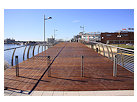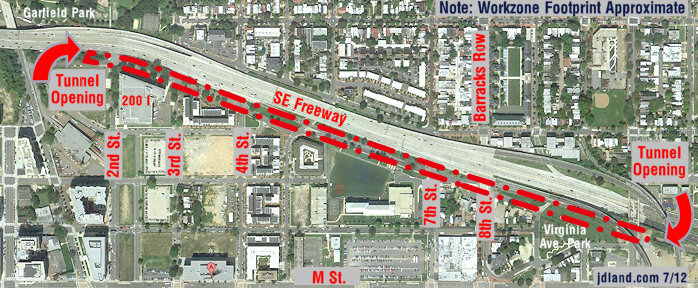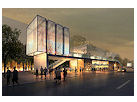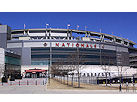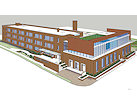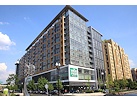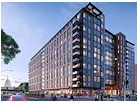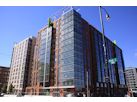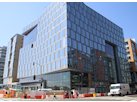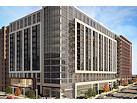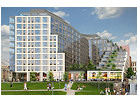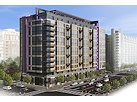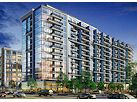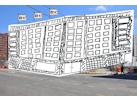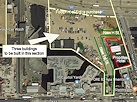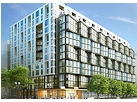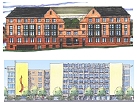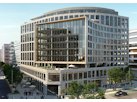|
| ||||||||||||||||||||
Please note that JDLand is no longer being updated.
peek >>
Near Southeast DC Past News Items
- Full Neighborhood Development MapThere's a lot more than just the projects listed here. See the complete map of completed, underway, and proposed projects all across the neighborhood.
- What's New This YearA quick look at what's arrived or been announced since the end of the 2018 baseball season.
- Food Options, Now and Coming SoonThere's now plenty of food options in the neighborhood. Click to see what's here, and what's coming.
- Anacostia RiverwalkA bridge between Teague and Yards Parks is part of the planned 20-mile Anacostia Riverwalk multi-use trail along the east and west banks of the Anacostia River.
- Virginia Ave. Tunnel ExpansionConstruction underway in 2015 to expand the 106-year-old tunnel to allow for a second track and double-height cars. Expected completion 2018.
- Rail and Bus Times
Get real time data for the Navy Yard subway, Circulator, Bikeshare, and bus lines, plus additional transit information. - Rail and Bus Times
Get real time data for the Navy Yard subway, Circulator, Bikeshare, and bus lines, plus additional transit information. - Canal ParkThree-block park on the site of the old Washington Canal. Construction begun in spring 2011, opened Nov. 16, 2012.
- Nationals Park21-acre site, 41,000-seat ballpark, construction begun May 2006, Opening Day March 30, 2008.
- Washington Navy YardHeadquarters of the Naval District Washington, established in 1799.
- Yards Park5.5-acre park on the banks of the Anacostia. First phase completed September 2010.
- Van Ness Elementary SchoolDC Public School, closed in 2006, but reopening in stages beginning in 2015.
- Agora/Whole Foods336-unit apartment building at 800 New Jersey Ave., SE. Construction begun June 2014, move-ins underway early 2018. Whole Foods expected to open in late 2018.
- New Douglass BridgeConstruction underway in early 2018 on the replacement for the current South Capitol Street Bridge. Completion expected in 2021.
- 1221 Van290-unit residential building with 26,000 sf retail. Underway late 2015, completed early 2018.
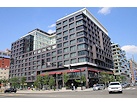
- NAB HQ/AvidianNew headquarters for National Association of Broadcasters, along with a 163-unit condo building. Construction underway early 2017.
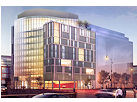
- Yards/Parcel O Residential ProjectsThe Bower, a 138-unit condo building by PN Hoffman, and The Guild, a 190-unit rental building by Forest City on the southeast corner of 4th and Tingey. Underway fall 2016, delivery 2018.
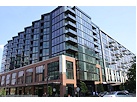
- New DC Water HQA wrap-around six-story addition to the existing O Street Pumping Station. Construction underway in 2016, with completion in 2018.
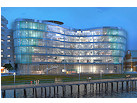
- The Harlow/Square 769N AptsMixed-income rental building with 176 units, including 36 public housing units. Underway early 2017, delivery 2019.
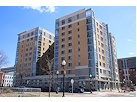
- West Half Residential420-unit project with 65,000 sf retail. Construction underway spring 2017.
- Novel South Capitol/2 I St.530ish-unit apartment building in two phases, on old McDonald's site. Construction underway early 2017, completed summer 2019.
- 1250 Half/Envy310 rental units at 1250, 123 condos at Envy, 60,000 square feet of retail. Underway spring 2017.
- Parc Riverside Phase II314ish-unit residential building at 1010 Half St., SE, by Toll Bros. Construction underway summer 2017.
- 99 M StreetA 224,000-square-foot office building by Skanska for the corner of 1st and M. Underway fall 2015, substantially complete summer 2018. Circa and an unnamed sibling restaurant announced tenants.
- The Garrett375-unit rental building at 2nd and I with 13,000 sq ft retail. Construction underway late fall 2017.
- Yards/The Estate Apts. and Thompson Hotel270-unit rental building and 227-room Thompson Hotel, with 20,000 sq ft retail total. Construction underway fall 2017.
- Meridian on First275-unit residential building, by Paradigm. Construction underway early 2018.
- The Maren/71 Potomac264-unit residential building with 12,500 sq ft retail, underway spring 2018. Phase 2 of RiverFront on the Anacostia development.
- DC Crossing/Square 696Block bought in 2016 by Tishman Speyer, with plans for 800 apartment units and 44,000 square feet of retail in two phases. Digging underway April 2018.
- One Hill South Phase 2300ish-unit unnamed sibling building at South Capitol and I. Work underway summer 2018.
- New DDOT HQ/250 MNew headquarters for the District Department of Transportation. Underway early 2019.
- 37 L Street Condos11-story, 74-unit condo building west of Half St. Underway early 2019.
- CSX East Residential/Hotel225ish-unit AC Marriott and two residential buildings planned. Digging underway late summer 2019.
- 1000 South Capitol Residential224-unit apartment building by Lerner. Underway fall 2019.
- Capper Seniors 2.0Reconstruction of the 160-unit building for low-income seniors that was destroyed by fire in 2018.
- Chemonics HQNew 285,000-sq-ft office building with 14,000 sq ft of retail. Expected delivery 2021.
884 Blog Posts Since 2003
Go to Page: 1 | ... 35 | 36 | 37 | 38 | 39 | 40 | 41 | 42 | 43 ... 89
Search JDLand Blog Posts by Date or Category
Go to Page: 1 | ... 35 | 36 | 37 | 38 | 39 | 40 | 41 | 42 | 43 ... 89
Search JDLand Blog Posts by Date or Category
At last, I've gotten the word on what's coming on Square 699N, the block bounded by Half, K, L, and 1st, owned by the Cohen Companies and the former home to nighclubs Wet, Edge, and Club 55, and a series of other small businesses. After what apparently was quite a ride through the DC raze permitting process, they are planning to begin exvacation in July for Phase I of their project (called "Velocity"), which will be a 200-unit condo building on the northwest corner of 1st and L; it will be delivered in late 2009, and will have retail as well. Phase II will be a "mirror-image" 200-unit condo building, at Half and K; Phase III is not yet written in stone, could be an office building, but will depend on What the Market Will Bear. (The three levels of underground parking for both condo buildings will be constructed during Phase I.) There will be a web site coming in May, and then in June a "state of the art" sales center will be opening at Half and K, so before long we should get some renderings of what it's all going to look like. In the meantime, demolition continues, and when we get a bright sunny day where it's not 40 below, I'll post some updated photos.
|
More posts:
Square 699n, Velocity Condos
|
The in-development Business Improvement District for Near Southeast (which they're branding as "Capitol Riverfront", though I currently remain unconvinced) has posted its Operating Plan and Draft Bylaws, after having released their Executive Summary a few weeks back. The Operating Plan sets out how they plan to address the areas identified as the biggest needs in the neighborhood: Clean, Safe, Marketing PR & Branding, Business Development, Infrastructure Development, and Community Building. In other words, the streets will be clean before Nats games and trash cans will be installed, fear not! Note that the BID still needs to get buy-in from neighborhood commercial property owners, and go through the legislative process and get approval from the city council before being officially created.
|
More posts:
Capitol Riverfront BID
|
It didn't take long this morning for the last three standing buildings between N and Van streets across from the ballpark to get taken down--the two rowhouses at 30 and 32 N are gone, and as of this moment the Good and Plenty Carryout at 36 N is in mid-demolition (the Clark Stadium Construction Cam [Camera #2] continues to provide birds-eye views of this work). So now we have Demolished Buildings #120-122; you can also see what this stretch of buildings has looked like over the past few years (up through yesterday evening) from Van and from Half. And I imagine I'll be back later today with an update on the progress of Square 669N's demolition.
UPDATE, 1:01 pm: I can also report that the Club 55 building, on the Square 669N site just east of the Half and K intersection, is now Demolished Building #123.
|
|
It's a demolition two-fer today--in addition to 26 N Street being knocked down on the Monument Realty land just north of the stadium, I was a little surprised to find that the wrecking crews started work today on Square 699N, taking down the red brick building/loading dock at Half and K (exposing some of the interior of Club 55) as well as the northwesternmost portion of the Edge/Wet building. You can see also at the top of my Square 699N page a well-timed shot of the entire block before demolition started, taken yesterday morning from the top floor of 20 M Street. And we've now got Demolished Building #119. I imagine the rest of the block is going to go pretty quickly. And then perhaps Mr. Cohen will tell us a bit more about what he's got planned for the site, beyond "mixed-use/office/condos."
|
More posts:
Square 699n, Velocity Condos
|
I wasn't expecting this one just yet, but today the red brick building at 26 N Street has been demolished (flip through the Stadium Construction Camera images from Camera #2 starting at 8:40 am to see it disappear); it was home for many years to the Patent Reproduction Company, until a deal was made by Monument Realty in August 2005 to purchase it for $3 million (see Post and WBJ articles from the time of the sale). This site is directly across from the stadium, but is not part of Monument's first phase of development in the area (which is in Square 701 on the east side of Half Street--the demolished building is on the west side, in Square 700 at Van and N streets); Square 700 redevelopment will probably not begin before 2009. But I'm guessing there might be some stadium parking made available on the north side of N between South Capitol and Half in the meantime. And 26 N has now been enshrined as #118 in my Demolished Buildings gallery; I imagine its neighbors (including the Good N Plenty carryout) are in their last days as well.
|
More posts:
Monument Valley/Half St., staddis
|
From the Spring 2007 newsletter of the Washington Humane Society (hat tip to reader Chuck): "As if being the largest Spay/Neuter Clinic in the Metropolitan area was not already enough, in June 2007, the Washington Humane Society will unveil the first ever low-cost Regional Spay/Neuter Center, created specifically to service the entire DC metropolitan area. The new facility will be named the National Capital Area Spay and Neuter Surgical Center. The current low-cost Spay/Neuter Clinic is located on Georgia Avenue in Northwest and will move to Capitol Hill, 1001 L Street, SE to a facility that is nearly four times the size of the current location. [...] The new National Capital Area Spay and Neuter Surgical Center will provide an average of fifty sterilization surgeries on both dogs and cats every day, five days a week." This is the building at the corner of 10th and L that has been being rehabilitated over the past few months. No word on whether Bob Barker will be making appearances in the Hood. UPDATE: Here's the building at 1001 L Street--definitely looks like it's getting prepped for occupants.
|
|
With thanks again to DDOT, I now have all of the slide presentations from last week's public meeting on the stadium Transportation Operations and Parking Plan (TOPP). The new ones are the WMATA Slides on Navy Yard Station Upgrade and the DDOT Slides on Douglass Bridge/Other Improvements. The documents I posted last week were the slides by Gorove/Slade describing about the TOPP; with maps and charts listing expected transit/auto/pedestrian traffic volume and flow; an FAQ on parking, traffic, and other issues for Southwest and Near Southeast residents; an FAQ on the Douglass Bridge improvements going on over the next few months; and DDOT's display boards with information on the plans for the South Capitol Street corridor and other regional traffic issues.
Repeating what I said last week: If you live in Southwest, or Near Southeast, or Capitol Hill, or Anacostia, or even Prince George's County, or if you're a baseball fan planning to come to the games, I suggest taking a close look at these.... (Some of them are kind of big files, be patient if they take a moment to load.) Comments can be sent to the the DC Sports and Entertainment Commission, and cc ANC 6D (office@anc6d.org) so that the ANC can track the feedback. And read my summary of the main bullet points from the meeting. Let's not all wait until March 2008 to suddenly figure out that there's a new baseball stadium at South Capitol and Potomac that has 40,000 fans trying to get there.
|
More posts:
ANC News, Metro/WMATA, parking, South Capitol St., Douglass Bridge, staddis, Nationals Park, Traffic Issues
|
Two upcoming events from the Anacostia Waterfront Corporation that might be of interest: On Earth Day, April 21, the AWC is running an Anacostia River Earth Day Cleanup and Celebration, with Canal Park being of the four cleanup sites (along with the Southwest Waterfront, Marvin Gaye Park, and Kenilworth Parkand Poplar Point). See their announcement for details, and also check out the Anacostia Watershed Society's Earth Day cleanup plans for the Anacostia. The next day, April 22, as part of Cultural Tourism DC's Walkingtown Tours, the AWC is sponsoring four different routes, none of which are actually in Near Southeast but which still might be of interest (the eastern riverfront and Poplar Point, Kingman and Heritage Islands, Hill East, and Marvin Gaye Park). The announcement has times and locations and whatnot.
|
|
The DC Property Sales database has a lag time of 6-8 weeks, so pretend today is February 1--that way I can tell you that Just Yesterday the sale was completed of the Nexus Gold Club land to developer JPI, for $7.85 million. They also purchased 920 First Street (the little grey auto repair garage next to the Nexus) for $2.45 million. In 2005 and 2006 they purchased other properties on this block (Square 738) for about $2.64 million, so they've now spent just under $14 million to get 18,000 square feet of land for what will be 909 New Jersey Avenue, a 230-unit residential tower schedule to start construction Any Minute Now. Note that the owner of the garage right on the northeast corner of 1st and K has steadfastly refused to sell (and has some choice words for JPI if you talk to him), so it will be interesting to see how that section of the site shakes out. Considering his neighbor got $2.4 million for 2,186 square feet of property, who knows how much he has turned down for his lot of the same size. There's one other lot on the block still not owned by JPI (925 New Jersey, 1412 sq ft), but I haven't heard anything about purchase problems with that lot, and it was covered by a zoning variance JPI received in 2006.
|
|
I gave you inside-the-ballpark photos on Monday, and today there's a new set of exterior shots of the Nationals baseball stadium (note that I've now separated the interior and exterior stadium photo galleries into separate tabs). Remember that clicking on the  icon will show you all uploaded photos of that angle, not just the oldest and newest (so you can watch the stadium construction change in two-week intervals). I also "freshened" the Photo Archive's database of photos at all the intersections around the perimeter of the stadium, giving you additional viewpoints not shown in the Construction Gallery: check out 1st Steet at N, N Place, O, and Potomac; Half Street at N and Potomac; and South Capitol Street at N, O, P, and Potomac. (You can also browse the archive by map to pick and choose locations.)
icon will show you all uploaded photos of that angle, not just the oldest and newest (so you can watch the stadium construction change in two-week intervals). I also "freshened" the Photo Archive's database of photos at all the intersections around the perimeter of the stadium, giving you additional viewpoints not shown in the Construction Gallery: check out 1st Steet at N, N Place, O, and Potomac; Half Street at N and Potomac; and South Capitol Street at N, O, P, and Potomac. (You can also browse the archive by map to pick and choose locations.)
 icon will show you all uploaded photos of that angle, not just the oldest and newest (so you can watch the stadium construction change in two-week intervals). I also "freshened" the Photo Archive's database of photos at all the intersections around the perimeter of the stadium, giving you additional viewpoints not shown in the Construction Gallery: check out 1st Steet at N, N Place, O, and Potomac; Half Street at N and Potomac; and South Capitol Street at N, O, P, and Potomac. (You can also browse the archive by map to pick and choose locations.)
icon will show you all uploaded photos of that angle, not just the oldest and newest (so you can watch the stadium construction change in two-week intervals). I also "freshened" the Photo Archive's database of photos at all the intersections around the perimeter of the stadium, giving you additional viewpoints not shown in the Construction Gallery: check out 1st Steet at N, N Place, O, and Potomac; Half Street at N and Potomac; and South Capitol Street at N, O, P, and Potomac. (You can also browse the archive by map to pick and choose locations.)I also did what is probably the final major photo update for 20 M Street, and updated some other intersections as well--Half and M, Cushing and M (both of which are part of the Monument Half Street footprint); Cushing and L; and 1st and M and 1st and L, home of the construction sites for 100 M Street and Onyx on First, which each got updated as well, although the pictures aren't particularly exciting (still just a big hole in the ground). Or you could just look at all the photos I took today, then click on the intersection link if you want to see previous photos.
And now, I must go watch my Gators.
|
|
Thanks to the fine folks at DDOT, I've now gotten a hold of some of the documents from yesterday evening's public meeting on the stadium Transportation Operations and Parking Plan (TOPP). First, here's the slides presented by consultants Gorove/Slade about the TOPP, with maps and charts listing expected transit/auto/pedestrian traffic volume and flow. There's also an FAQ on parking, traffic, and other issues for Southwest and Near Southeast residents. In addition, DDOT handed out an FAQ on the Douglass Bridge improvements going on over the next few months, and they also had a number of display boards with information on the plans for the South Capitol Street corridor and other regional traffic issues. If you live in Southwest, or Near Southeast, or Capitol Hill, or Anacostia, or even Prince George's County, or if you're a baseball fan planning to come to the games, I suggest taking a close look at these.... (Some of them are kind of big files, be patient if they take a moment to load.) UPDATED to correct the link to the Gorove/Slade presentation; there's also now more slides (from DDOT and WMATA) available here.
|
|
From today's print edition of the Washington Business Journal: "CNN and a couple of law firms are sampling the wares in Southeast DC by taking tours of new office buildings cropping up around the new baseball stadium. No leases have been signed yet, but the buzz of these high-profile tenants looking at Southeast as an option is quite a victory for a neighborhood formerly known as an industrial zone crawling with seediness and crime. [...] Also, rents in Southeast are expected to be around $40 per square foot for full service, $20 to $30 cheaper than new or renovated buildings in the Central Business District." Of course, right now, "tours of new office buildings" means 20 M Street, the only new office building currently completed and with plenty of space to lease. But by 2009 there will also be 100 M, 55 M, and probably 250 M and 1111 New Jersey. And maybe a couple more, depending on what happens within the next few months at Square 699N, Square 697 (Nation), and the Willco site at 83 M. (The article fudges a bit by mentioning 1.8 million square feet of office space was under construction in Near Southeast back in December, but, well, 1.35 million of that was the DOT HQ.) UPDATE: Added the link to the story, since WBJ was nice enough to bring it out from behind the pay wall.
|
More posts:
100 M, 1015 Half, 20 M, 20 M, US Dept. of Transportation HQ, Monument Valley/Half St., Square 743N, square 697, Square 699n, Square 701
|
It was a tough call between swallowing a couple of bottles of hydrochloric acid or attending tonight's public meeting on the stadium's Transportation Operations and Parking Plan, but luckily for you my JDLand duties eventually won out. I'm hoping to get electronic versions of the slide presentations, so I'm going to just type up my notes for now, and hope that the details come later; besides, much of it will sound familiar to folks who read this blog regularly. There were presentations by DDOT and WMATA about their plans for the area, as a warm up for the discussion by traffic planners Gorove/Slade on the TOPP.
DDOT gave an overview of all of its near-term plans for Near Southeast--this includes the additional ramps to be added to the 11th Street Bridges, which already has funding and is moving at (bureaucratically speaking) lightning speed, and should be done by 2010. Then the planned improvements to South Capitol Street and the South Capitol Street Bridge were profiled, including this summer's festive demolition and lowering of the northern portion of the bridge. The current bridge itself will also be painted, and will get new lighting and pedestrian rails (more like the Pennsylvania Ave. bridge). Then there will be the streetscape improvements to South Capitol, Potomac, N, 1st, and I Streets, SE, all before Opening Day 2008, with resurfacing, new streetlights, curbs, etc. There will also be some small changes to the South Capitol and I intersection to try to improve the flow, although there are no current plans to expand the ramps to/from the freeway.
Next up was WMATA, giving a description of what's being done to expand the Navy Yard Metro station in advance of the throngs of baseball fans. The station's capacity is being upgraded to 15,000 customers per hour (the same as Stadium-Armory) from the current 5,000, turnstiles and Farecards machines will be moved to street-level, elevators will be added to the west entrance, and more, all while Monument Realty's 55 M Street office building is built on top of the station. The west entrance will be one-way outbound before games and one-way inbound afterwards, while the east entrance will remain two-way. Metro will also put in place the same plan of 9-13 extra trains after each game that they currently do for games at RFK, and that the system's recent receipt of nearly 190 new rail cars will also help increase capacity over the next 18 months. They are also looking at shuttles to other stations after games, and that the possibility exists that DDOT could expand the DC Circulator bus routes that currently end in SW to include the stadium area, with a route down M Street, up 8th, and over to Union Station, but that's not decided yet.
Gorove/Slade went through a lot of numbers, but I think in some ways didn't quite emphasize what the people attending wanted to hear most, which is that non-resident gameday street parking will be prohibited in basically all residential areas in Southwest and Near Southeast south of the freeway, and they'll be using the model that's been being refined in the Hill East neighborhood around RFK for the past few years (residents receive Event Parking permits to display, and also one guest parking permit per household). They estimate that for a sellout crowd 19,000 people will come via transit (16,000 through the Navy Yard station), 750 will arrive by charter buses, 400 by taxi, 3,400 on foot or bike, and 13,600 by car (in 4,700 vehicles). They indicated that the Nationals themselves are in charge of coordinating the parking negotiations with various sites, and a slide showed that the Nationals have identified about 5,200 parking spaces that can be available (well above the 4,700 vehicles anticipated to be coming to games). Only 185 of these spaces are in Southwest (between Half and South Capitol north of M); the rest are all in Near Southeast. While there are possibilities for parking in Buzzards Point, currently it appears the Nationals are not anticipating using that area for parking. No decision has been made yet on using the RFK parking lots and shuttle buses.
In terms of pedestrian flow at game time, many of the surrounding sidewalks are to be upgraded as part of DDOT's streetscape improvements. There will be traffic control officers at the major intersections, and Half Street SE south of M will be closed entirely to vehicle traffic, while some lanes on N will be closed; also there will be no parking at all on M Street or on 1st Street north of M on gamedays.
But what all the planners want is for people to come to games via public transit.
The questions from the audience centered mainly around the impact on the residential streets of Southwest and Capitol Hill, with great concerns about parking for visitors ("what if I'm having a party?") on game days. I imagine there will be more of the meetings, with more consternation, yet to come. And I also imagine that Opening Day 2008 will be rife with tales of traffic back-ups, transit snafus, and lost suburbanites unable to find their parking lots. And then the plans will be tweaked and re-tweaked, just as they have been around RFK for the past few years.
As I said, hopefully I'll have the slides and some other materials to pass along within the next few days. If you have concerns that you want to air, be sure to contact the DC Sports and Entertainment Commission, and cc ANC 6D (office@anc6d.org) so that the ANC can track the feedback.
UPDATE: See my entry with the slides from the meeting, now posted on my site.
|
|
I've added the Navy Museum's slate of public programs for the month of April to my Upcoming Events calendar--nice weather to stroll down to the Navy Yard, you can even walk on the completed section of the Anacostia Riverwalk (after you promise your first-born to the guards at the entrance gates) and gaze longingly westward past the fence toward what will eventually be the Waterfront Park at the Yards.
|
More posts:
Navy Yard
|
Goings on about town.... Earlier this week the construction crane arrived at the Onyx on First/100 M Street construction site, signaling the beginning of the end of the digging-down phase and the start of the building-up phase. (Though these two projects are being developed by different companies, they are being built concurrently--that's synergy, and cost savings!) Two blocks over, a big sign has gone up at 2nd and M advertising Washington Canal Park--the graphic on the sign is the same one I found a few weeks back in the Capitol Riverfront BID executive summary. And, today, fences have been erected around Square 699N, the entire block bounded by Half, K, L, and 1st, the former home to Wet/Edge and various other small businesses. Permits appear to be in place for demolition and excavation, so with the fences up I'd expect something to start happening soon--now if only the Cohen Companies would tell us WHAT! You can see a few new shots on my Square 699N and Canal Park pages, or here in the Photo Archive all at once. UPDATE: I should add that, back in September 2005 when Ron Cohen purchased Square 699N, it was reported that the block would be developed with 650 condos, a hotel with condos, a stand-alone 250,000 sq ft office building, and retail. But there's been little reporting since on his plans.
|
|
A reminder about Thursday's big neighborhood meeting: "The public is invited to learn about the recommendations for the Traffic Operations & Parking Plan (TOPP) and to discuss issues pertaining to traffic planning for the new Ballpark District and nearby neighborhoods. Representatives from the DC Department of Transportation, Metropolitan Police Department, the Washington Nationals and the Sports Commission will be on hand. The meeting runs from 6:30 to 8:30 p.m. on March 29 at Southeastern University, 501 I St., SW. For information, call the new Ballpark Hotline at (202) 608-1112 or visit www.washdcsports.com."
UPDATE: You can now read my summary of the meeting and also see the slides.
|
|
Today I've added some expanded information on The Yards, the 44-acre redevelopment project by Forest City Washington on the Southeast Federal Center site (behind DOT on M Street, stretching from 1st Street to the Navy Yard at Hull Street, and down to the Anacostia River). They are beginning to move forward with their first phase of projects, which will start this spring with the building of roads and infrastructure within the site (we should see new signs for The Yards at 1st and N and other locations relatively soon). In early 2008, work should begin on the first two big projects, which are the redevelopment of Building 167 (the old Boiler Maker's shop on Tingey between 3rd and 4th) into a retail building, and the rehabilitation and expansion of Building 160 across the street (the Pattern/Joiner shop) into a residential building; these are expected to be completed in 2009. This first phase will also include the renovation of Building 202 (the Gun Assembly Shop) at 5th and M into another residential building; this site (which I long ago dubbed the "JD Lofts") will be a joint project between Forest City and PN Hoffman. Also, expect to see demolition within the next few months of the beige brick building at 1st and N across from the Nationals ballpark, so that this parcel can be turned into stadium parking, at least for a few years until office buildings are built there. Rounding out Phase 1 will be the construction of the Waterfront Park at the Yards, a 5.5-acre public space along the banks of the Anacostia, which is just now starting to be designed. This will be connected to Diamond Teague Park south of 1st Street by a floating pedestrian bridge, which sounds kind of cool.
You can get a better feel for all of this by looking at the map and photos I've added to a new Yards Overview tab, and then also look through the photos I have of the site, or use the Photo Archive to check out the perspectives at 1st and N and along Tingey at New Jersey, 3rd, 4th, 5th, and Hull.
|
|
An e-mail has gone out to folks who have registered with the Capitol Quarter townhome development announcing that the hours of the sales office at 4th and L have been temporarily cut back to 11 - 6 Saturdays and Sundays, with weekday hours by appointment. "These new hours are only temporary - once the release date of our next homesites is known, our office will return to being open 11 am to 6 pm daily." Hopefully there will be news on the next release of units by the end of spring; the first 40 houses (market-rate and workforce-rate) were snapped up in the blink of an eye, and it'll be interesting to see if the level of interest is the same on the next go-round.
|
More posts:
Capper, Capitol Quarter
|
From DDOT, a drill everyone should be getting familiar with: "As part of ongoing improvements to the Frederick Douglass Memorial Bridge (sometimes referred to as the South Capitol Street Bridge), the District Department of Transportation (DDOT) will continue bridge repairs this weekend, starting Friday, March 30. Following the morning rush hour this Friday, DDOT will temporarily close the inbound lanes on the Frederick Douglass Memorial Bridge. Inbound bridge drivers will be directed to follow signed detours on Interstate 295 North to the 11th Street Bridge - providing direct access into the District. The inbound lanes will be closed beginning on Friday, March 30 at 10 a.m. until as late as Monday, April 2 at 4 a.m. All lanes will be reopened in time for the Monday morning rush hour."
Why? (in case you're just joining us) "The off-peak closures and repairs are needed to prepare for a major rehabilitation that will take place on the Frederick Douglass Bridge in July and August - at which time all lanes on the bridge will be closed in both directions. [...] The one-direction-only weekend closures on the Frederick Douglass Memorial Bridge are necessary to allow workers to safely replace bridge expansion joints with new joints (joints allow a bridge to flex when temperature changes occur). Joint replacement work requires extended periods of uninterrupted work hours, as it involves removing existing joints from the concrete bridge deck, making necessary repairs, installing new joints and placing concrete to reconnect the existing bridge deck to the new joints. Under-the-bridge steel repair work and painting also will occur. The weekend closures and repair work, which are scheduled to conclude in early June 2007, also may require periodic single-lane closures during weekday non-peak travel times.
"During the July-August closure, the northernmost portion of the bridge will be lowered to become an at-grade roadway with a new intersection at South Capitol Street and Potomac Avenue. Nearly three blocks of elevated roadway - which currently act as a barrier to access across South Capitol Street - will be removed and replaced with at-grade intersections that will help knit the neighborhood together. Additional improvements will occur such as paving and painting the entire bridge."
See my Upcoming Events calendar for the planned closures from now through June.
|
|
On March 26 29 at 6:30 pm, the DC Sports and Entertainment Commission is holding a Public Meeting on the Nationals Ballpark Traffic Operations and Parking Plan, which should be a festive meeting-of-the-minds between the public and representatives of DDOT, the Metropolitan Police Department, the Nationals, and the DCSEC. See the front-page story from the April Southwester for more information. UPDATE, 3/27: It would help if I could *read* - the meeting is this Thursday, March 29, not yesterday.
|
More posts:
parking, Nationals Park
|
884 Posts:
Go to Page: 1 | ... 35 | 36 | 37 | 38 | 39 | 40 | 41 | 42 | 43 ... 89
Search JDLand Blog Posts by Date or Category
Go to Page: 1 | ... 35 | 36 | 37 | 38 | 39 | 40 | 41 | 42 | 43 ... 89
Search JDLand Blog Posts by Date or Category



